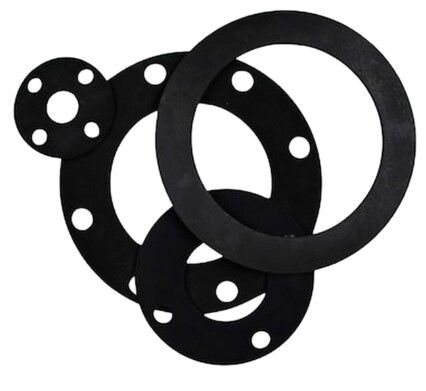In the industrial field, the choice of sealing materials is crucial for the normal operation and safety of equipment. PTFE gaskets and rubber gaskets, as common sealing materials, each have their unique advantages and applicable scenarios. This article will delve into the performance characteristics, application range, and how to select between these two types of gaskets according to actual needs, helping you make an informed decision among various sealing materials.
Among many sealing materials, PTFE gaskets stand out with their excellent performance. They not only excel in high-temperature resistance and corrosion resistance but also demonstrate strong adaptability in various complex application scenarios.

PTFE gaskets exhibit extraordinary stability under extreme temperature conditions. They can maintain consistent performance within a wide temperature range from -200°C to +260°C. Whether in the extreme cold of polar regions or the high temperatures of industrial furnaces, they can easily cope. This excellent high-temperature performance makes them indispensable in many high-temperature sealing applications.
In the chemical industry, various corrosive media pose severe challenges to sealing materials. PTFE gaskets stand out due to their excellent corrosion resistance. They almost do not react with any chemical substances; whether strong acids, strong bases, or organic solvents, none can corrode them. This means that in chemical, pharmaceutical, and other industries, using PTFE gaskets can effectively prevent chemical leakage and ensure production safety.
The surface of PTFE gaskets is smooth, providing excellent non-stick properties. This feature not only makes installation and removal more convenient but also reduces friction and extends equipment lifespan. In equipment that requires frequent assembly or high precision, this characteristic of PTFE gaskets is particularly important.
PTFE gaskets can be processed into various shapes through mechanical turning, cutting, or mold pressing, such as flat gaskets, V-shaped gaskets, piston rings, and ball valve seats. Additionally, they can be combined with other materials to create composite gaskets, such as PTFE-coated gaskets or spiral-wound gaskets, to meet different sealing requirements. This diversity in processing allows PTFE gaskets to adapt to various complex sealing scenarios.
Due to the above advantages, PTFE gaskets are widely used in chemical, petroleum, pharmaceutical, and food industries. In the chemical industry, they are used to seal various reactors, pipelines, and valves to prevent chemical leakage. In the petroleum industry, they are used in oil wells and refining equipment to ensure the safety of oil extraction and processing. In the pharmaceutical industry, they are used to seal production equipment, ensuring product quality and safety. In the food industry, they are used to seal food processing equipment, preventing contamination.
When seeking a cost-effective choice in the world of sealing materials, rubber gaskets undoubtedly stand out. They are like the "economical player" of sealing, providing reliable sealing solutions for many industrial applications with affordable prices and practical performance.

The greatest advantage of rubber gaskets lies in their good elasticity and compressibility. This feature allows rubber gaskets to form a reliable seal between different surfaces, even when there are surface irregularities or gaps, by deforming elastically to fill these defects, thus achieving a reliable sealing effect. This feature is particularly prominent in equipment that requires quick assembly and disassembly.
Compared with PTFE gaskets, rubber gaskets are relatively low in price. This makes them more competitive in cost-sensitive applications. For small and medium-sized enterprises or budget-limited projects, choosing rubber gaskets can effectively reduce production costs while ensuring sealing performance.
Rubber gaskets are relatively simple to process and can be made into various shapes and sizes according to different needs. During installation, rubber gaskets are also convenient, requiring no complex tools or equipment; they only need to be placed at the sealing location and fixed with bolts or other fasteners. This ease of processing and installation makes rubber gaskets widely used in many scenarios.
Rubber gaskets also have some wear resistance and impact resistance, allowing them to be used in environments with mechanical movement or vibration. For example, in machinery such as mechanical transmission equipment or vibrating screens, rubber gaskets can withstand a certain degree of mechanical impact and wear, maintaining stable sealing performance.
When selecting sealing materials, understanding the performance characteristics of different materials is essential. PTFE gaskets and rubber gaskets are two common sealing materials, each with unique properties and applicable scenarios. The detailed comparison is as follows.
PTFE gaskets have much better high-temperature performance than rubber gaskets. Rubber gaskets have relatively poor heat resistance and can generally only be used within a lower temperature range. For example, natural rubber should not exceed 90°C for long-term use, while PTFE gaskets can maintain stable performance at temperatures up to +260°C.
PTFE gaskets have extremely strong corrosion resistance and almost do not react with any chemicals. Rubber gaskets' corrosion resistance varies by material. For example, fluororubber has good corrosion resistance, but other types of rubber gaskets may be corroded by strong acids or bases.
PTFE gaskets are relatively hard and may not be suitable for applications requiring compression or deformation. Rubber gaskets have good elasticity and compressibility, enabling effective sealing between surfaces. In scenarios with strict surface sealing requirements, this characteristic of rubber gaskets can better meet needs.
PTFE gaskets, due to their excellent non-stick and low-friction properties, reduce wear on equipment, thereby extending service life. Rubber gaskets, over long-term use, may gradually age due to mechanical wear or chemical corrosion, resulting in reduced sealing performance.
Choosing between PTFE and rubber gaskets requires comprehensive consideration based on specific application requirements. The following factors should be considered.
If the environment requires high temperature, corrosion resistance, and high sealing performance, PTFE gaskets may be the better choice. For example, in chemical reactors or oil wells, PTFE gaskets can effectively prevent chemical leakage and ensure production safety. If temperature and corrosion resistance requirements are not high, but elasticity and compressibility are needed, rubber gaskets may be more suitable. For instance, in mechanical transmission equipment or vibrating screens, rubber gaskets can withstand mechanical impact and wear while maintaining stable sealing performance.
If the budget is limited, the price advantage of rubber gaskets may be more attractive. Rubber gaskets are relatively inexpensive, ensuring sealing performance while reducing production costs. However, if the application demands high-performance sealing, PTFE gaskets, though more expensive, can improve equipment reliability and safety, reducing maintenance costs and production losses caused by seal failure in the long term.
Rubber gaskets are relatively easy to install, requiring no complex tools—simply place and secure with bolts. PTFE gaskets may require more attention during installation to ensure stable sealing. Regarding maintenance, PTFE gaskets usually do not require frequent replacement due to their excellent performance, while rubber gaskets may age over time and require regular inspection and replacement.
If high sealing reliability is needed under extreme conditions, PTFE gaskets can meet the demand. They maintain stable sealing in high-temperature, high-pressure, and highly corrosive environments. If the sealing requirement is relatively low, rubber gaskets' elasticity and compressibility can better adapt to different surfaces and achieve effective sealing.
PTFE and rubber gaskets, as two representative sealing materials, each have unique advantages and applicable scenarios. PTFE gaskets, with their outstanding high-temperature performance, superior corrosion resistance, excellent non-stick and low-friction properties, are widely used in chemical, petroleum, pharmaceutical, and food industries. Rubber gaskets, with their good elasticity and compressibility, price advantage, ease of processing and installation, and certain wear and impact resistance, are more competitive in cost-sensitive applications or those requiring elasticity and compressibility.
When choosing sealing materials, it is necessary to consider the application environment, budget, installation and maintenance requirements, and sealing demands comprehensively. Only by selecting the most suitable sealing material can equipment operate normally and safely, improving production efficiency and economic benefits. This article aims to help you better understand the characteristics and selection methods of PTFE and rubber gaskets, providing a reference for your sealing needs.